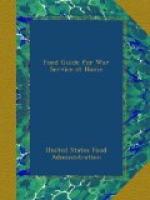THE MEAT RATIONS OF EUROPE
The shortage has compelled vigorous control of consumption in order to make the distribution as nearly fair as possible. Compulsory meat rations are enforced in all the warring countries. They vary, of course, from time to time as the amount of available meat changes, but the following statements give a picture of how limited the allowances are in periods of shortage.
England did not suffer for lack of meat at the outset of the war. Her voluntary ration (November, 1917) was generous, 2 pounds per week. In the beginning of 1918 the supply was very low, and by the end of February London was put on meat rations, and in April the rest of the country. The rationing system has made distribution easier and more fair and greatly lessened the distressing “queues” of people waiting before butchers’ shops for their allowance. The regulations allow each person 4 coupons a week. Children under 10 are on half-rations. At first, 3 of these coupons could buy 5 pence’ worth of beef, pork, or mutton, and one had to be used for a limited amount of bacon, ham, poultry, or game. The total amounted to about 11/4 pounds of meat a week.
Because of the increased amount of bacon and ham which the United States was able to send in the late spring, heavy workers were permitted in May 2 extra coupons, for which they might buy a pound of bacon. Boys between 13 and 18 years were allowed 1 extra coupon for bacon, poultry, or game. But at the same time only 2 instead of 3 coupons were to be used for fresh meat, so as to cut down further the slaughtering of cattle. Heavy fines are imposed for wasting food or profiteering.
In the restaurants the meat portions are about a fifth of the size of those served in an American hotel. An American staying in London said recently that he could eat two meals in succession in a London restaurant, and leave the table still minus that self-satisfied feeling that a meal in America gives.
At first France used meatless days instead of rations, and in the spring of 1918 went back to meatless days. High prices also keep down consumption. In July, 1917, there were 2 meatless days, and cattle could not be slaughtered on the 2 preceding days. Though this order was abolished in October, 1917, meat had gone up so high in price that consumption went away down. The Paris letter of the London Daily News and Leader on February 28, 1918, says that rump steak was selling for 4 shillings 2 pence—$1 per pound. Since May 15, 3 days a week must be meatless—Wednesday, Thursday, and Friday. On these days all butchers’ shops are closed. Horse meat may be sold, but no poultry or game. Fish is scarce and very expensive.
Italy has meatless days, formerly 2, and since May, 1918, 3. The ration and the number of cattle to be slaughtered are decided locally and strictly regulated.
The Central Powers probably have the lowest meat ration. The quantities allowed vary in different parts of the country, but the average in Germany has been about 9 ounces a week per person. It was reported that this was reduced to 6 ounces in the middle of May—barely two small servings each week.




